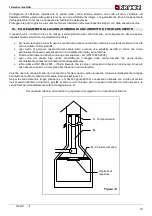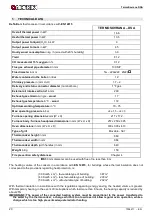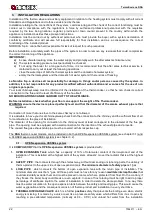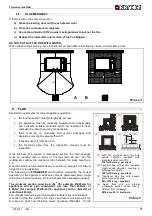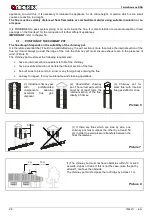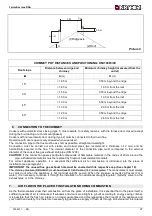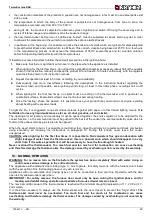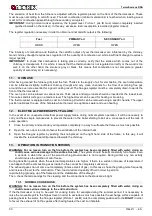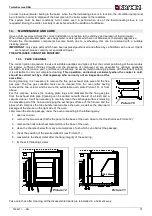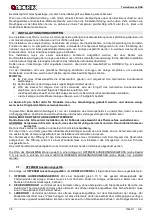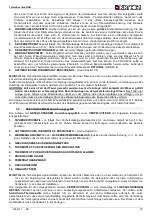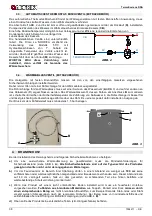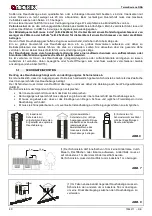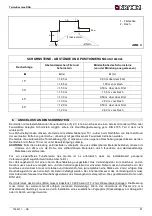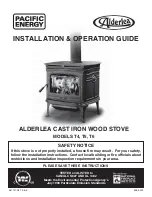
TermoSovrana
DSA
7094211 – EN
29
•
the construction materials of the products in question are not homogeneous; in fact cast iron and steel parts exist
side by side.
•
the temperature to which the body of the product is subjected is not homogeneous: from zone to zone, the
temperatures recorded vary from 300 °C to 500 °C;
•
during its life, the product is subjected to alternate cycles of ignition and switch-off during the same day and to
cycles of intense usage and complete rest as the seasons change;
•
the new thermocooker, before it can be defined as “tested”, must be subjected to various start up cycles in order
to allow all the materials and the varnish to complete the various elastic stresses;
•
in particular at the beginning, it is possible to notice the emission of smells which are typical of metals subjected
to great thermal stress and varnish which is still fresh. This varnish, despite being baked at 250°C for a few hours
in the manufacturing process, must exceed the temperature of 350°C several times and for a certain duration,
before incorporating itself perfectly with the metal surfaces
It therefore becomes important to follow these small precautions in the ignition phase:
1.
Make sure that there is significant air turnover in the place where the appliance is installed.
2.
When lighting for the first few times, do not load the combustion chamber excessively (about half of the quantity
shown in the instruction manual) and keep the product lit for at least 6-10 hours continuously, with the registers
open less than shown in the instruction manual.
3.
Repeat this operation at least 4-5 times, according to your availability.
4.
Subsequently load more (nevertheless following the descriptions in the instruction booklet regarding the
maximum load) and if possible, keep ignition periods long, at least in this initial phase, avoiding short on-off
cycles.
5.
When lighting for the first few times, no object must be resting on the thermocooker and in particular on
enamelled surfaces. Enamelled surfaces must not be touched during heating.
6.
Once the “testing” phase has passed, it is possible to use your product like you would a car engine, avoiding
abrupt heating with excessive loads.
To light the fire, it is suggested to use small wood pieces together with paper or other traded lighting means.
It is
forbidden to use any liquid substance as for ex. alcohol, gasoline, oil and similar.
The openings for air (primary and secondary) must be opened together, the smoke register is to be adjusted for the
cooker function, i.e. the command bar must be pushed to the back of the cooker (the eventual butterfly valve which is
found on the exhaust smoke pipe is also to be opened).
When the wood starts to burn, it is possible to load other fuel, close the primary air register and check combustion
using secondary air following the instructions in paragraph 10. During this phase, never leave the cooker
unsupervised.
CAUTION: when lighting for the first few times, it is possible to find consistent flue gas condensation with
slight leakage of water from the thermocooker; this is a phenomenon which should disappear in a very
short time. If it results as persistent, it will be necessary to have the flue draught checked.
Never overload the thermocooker. Too much fuel and too much air for combustion can cause overheating
and therefore damage the thermocooker. The damage caused by overheating is not covered by the warranty.
10. NORMAL OPERATION
WARNING: For no reason turn on the fire before the system has been completely filled with water; doing so
could cause serious damage to the entire structure
.
The appliances with automatic door closing (type 1), must operate, for safety reasons, with the furnace door closed
(with the exception of the fuel loading phase or any ash removal).
Appliances with non-automatic door closing (type 2), must be connected to their own flue. Operation with the door
open is only allowed under supervision.
IMPORTANT: For safety reasons, the furnace door must only be open during the ignition phase and for
loading wood whilst during operation and periods of non-use it must remain closed.
The nominal calorific power of the thermocooker is reached with a minimum draught (depression) of 17 - 20 Pa (=1.7-
2mm water).
It is therefore necessary to always use the thermocooker with the door closed to prevent the “forge” effect.
The
thermocooker must never be overloaded. Too much fuel and too much air for combustion can cause
overheating and therefore damage the thermocooker. The damage caused by overheating is not covered by
the warranty.





